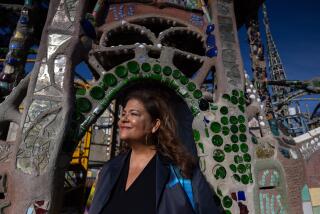Classic-books school saves a classic hall
ANNAPOLIS, Md. â The past year has not been especially kind to the memory of modern architect Richard Neutra, who died in 1970. One of his best-known residences, the 1962 Maslon House in Rancho Mirage, was torn down in March. The National Park Service threw its support behind a plan to demolish Neutraâs 1961 Cyclorama Center at Gettysburg National Military Park.
But at least one Neutra building is ending the year in better shape than it began. St. Johnâs College in Annapolis has completed a $12.9-million restoration and modernization of Mellon Hall, the 1959 classroom and laboratory building that the California-based architect designed for its campus.
Because of the collegeâs efforts, one of the few remaining Neutra buildings on the East Coast has a secure future, and St. Johnâs has a modern classic enhanced by sensitively designed improvements that make it more useful than ever.
St. Johnâs is better known for its classic books than its classic buildings, modern or otherwise. All students are required to focus their studies on approximately 130 âGreat Books.â
Neutra and St. Johnâs came together when the architect was invited to give a lecture on campus in April 1954. The college, which traces its history to 1696, was planning to expand on the north end of campus.
Born in Vienna in 1892 and educated in the universities of Vienna and Zurich, Neutra had moved to America in 1923 to practice architecture. He settled in California and made his mark with simple structures that had flat roofs and expansive glass-window walls that showed off the surroundings. One of the few architects ever featured on the cover of Time magazine, he was particularly known for blurring the lines between the interior and exterior of a building.
When he went to St. Johnâs, Neutra was at the peak of his popularity. A recent article in Time described him as second âonly to the lordly Frank Lloyd Wright,â with whom he studied. His lecture at St. Johnâs was part of a speaking tour to promote his book, âSurvival Through Designâ (Oxford University Press, 1969), which outlined his approach to architecture. In it, he argued that modern architecture must go beyond providing shelter and act as a social force to improve mankind.
âNeutra created a unique and visionary architecture that integrated nature, environmental responsibility, science, technology and an optimistic humanism,â said Steve Ziger, a partner in the firm of Ziger/Snead Architects, which was hired in 1999 to carry out the renovation. âHe established an eloquent and dramatic relationship between modern building technology and carefully controlled landscapes.â
Richard Weigle, then St. Johnâs president, was impressed with Neutraâs views. He also saw the potential benefit of having a celebrity architect design the collegeâs new building, which would be the largest on campus.
Neutra wanted more work on the East Coast. One year after the lecture in Annapolis, he signed a contract to design the St. Johnâs building for considerably less than their regular fee.
It was an unconventional choice for St. Johnâs and Annapolis, so steeped in colonial history. But it suited the governors of the college, who wanted to contribute to the campus the best in contemporary architecture. The selection also won support from donors, including philanthropist Paul Mellon, a St. Johnâs graduate whose Old Dominion Foundation gave $1.25 million toward construction, more than half the total cost of $2.1 million.
Neutra spent time on St. Johnâs campus, consulting with faculty members, attending classes and learning about the Great Books program.
The 99,000-square-foot building was designed to contain classrooms, offices, laboratories and an auditorium. Like many of Neutraâs schools, it is a low, abstract building that originally had an outdoor courtyard in the center, opening to a larger green space beyond. The buildingâs large horizontal windows and relatively low scale help integrate it with the campus while making it seem smaller than it is.
One of its distinctive features is a series of aluminum louvers, linked to motors, that enable occupants to open or close them depending on the amount of natural light they want.
Despite Neutraâs attention to detail, the building had its share of flaws. Its central court never got much use. Its long and unbroken corridors were monotonous and dark. The solar louvers, while innovative and environmentally responsible, broke down soon after opening day and were never fixed. Mechanical and electrical systems were quickly outdated. Interior spaces lacked air conditioning. The roof leaked. The auditorium was inadequate. A reflecting pool around the planetarium couldnât hold water.
Later additions closed off the court and negated Neutraâs effort to create a building that was open to its surroundings. Part of the problem was that design ideas that worked in California may not have translated well to Maryland. A tight construction budget also led to shortcomings that would not have emerged if the building had been better funded from the start.
Asked to renovate and modernize the building, principal-in-charge Steve Ziger and project architect Joseph Cellucci aimed to capitalize on the best of Neutraâs principles and designs and address as many of the flaws as possible. The architects conducted extensive research on Neutra and consulted with his son, Dion, an architect who shared insights about his fatherâs design philosophy.
âWhen we first took on the renovation, there was a generalized belief at the college that modern architecture was kind of evil, in part because of the problems with the building over the years,â Cellucci said. âWe thought we would be successful if we changed that perception.â
The renovations began in April 2001. As of this fall, the exterior has been restored, and the classrooms, offices and common spaces have been improved. Modern mechanical and electrical systems were installed. The auditorium has been renovated. Even the louvers work again.
A red-tile floor was installed to humanize and brighten once-dark corridors. A solarium cafe was created to add life to the center court, and a new wing houses a pottery studio, darkroom and a teleconferencing and seminar center called the Hodson Trust Conference Room. Both the cafe and Hodson Trust wing are compatible with Neutraâs original design.
Not every flaw has been addressed. The additions that closed in the center court were left in place and will most likely remain, and other problems wonât be fixed until money becomes available.
For now, though, the recent changes have brought new luster to a modern classic.
*
Edward Gunts is architecture critic at the Baltimore Sun, a Tribune company.
More to Read
The biggest entertainment stories
Get our big stories about Hollywood, film, television, music, arts, culture and more right in your inbox as soon as they publish.
You may occasionally receive promotional content from the Los Angeles Times.










